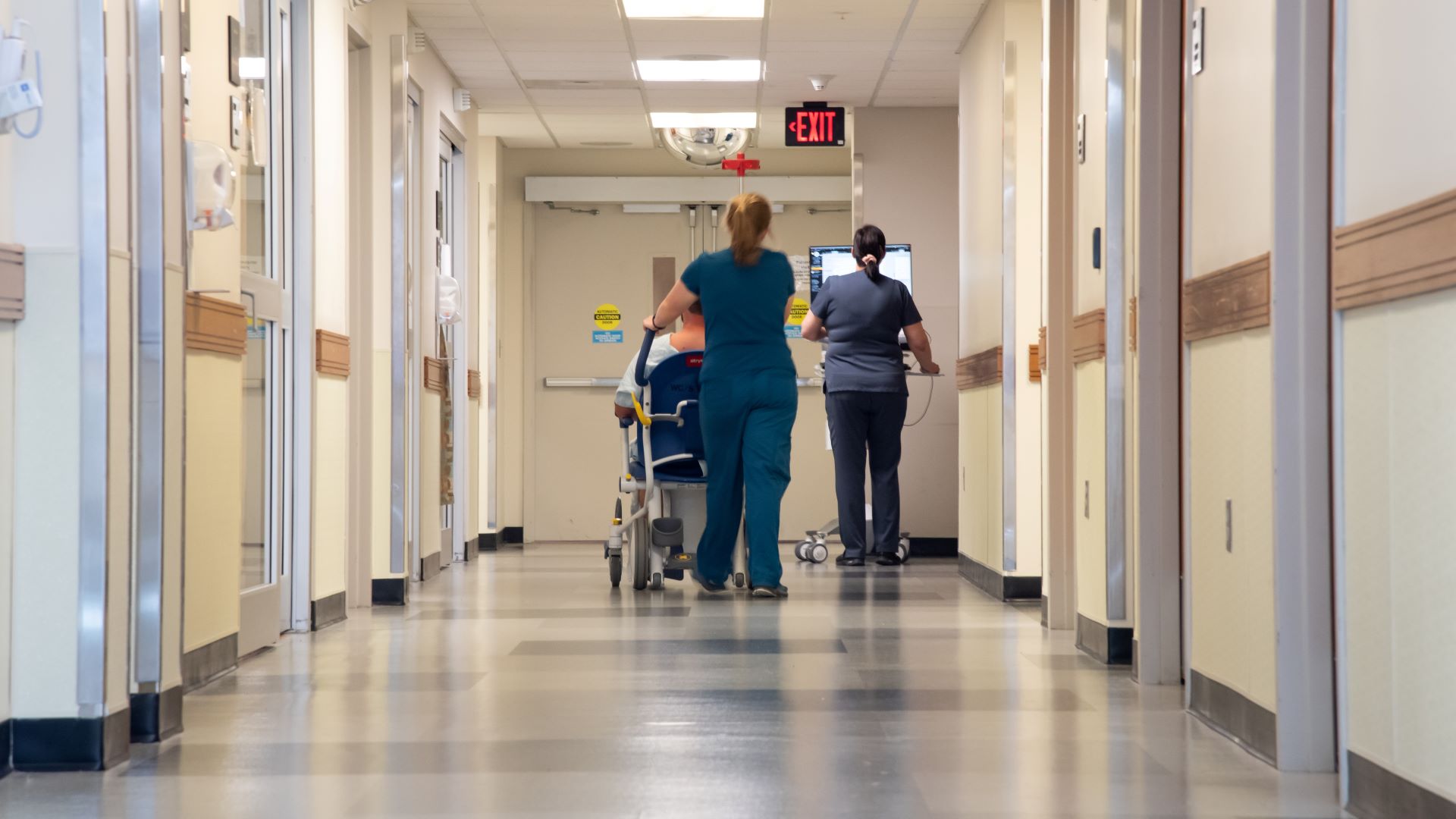Medical patients in Washington County are feeling the impact of workforce shortages in healthcare, from a lack of ambulance transport to a scarcity of available hospital beds as far away as Boston.
No one knows that more than Eastport resident Jana Sutherland, who spent the last seven months caring for her mother, Marguerite Sullivan, before she passed away in January. Her mother was eventually diagnosed with multiple and serious illnesses, but it took the entire seven months for her to receive proper diagnoses and care.
“Nobody should have to go through a terrible time of it trying to get a timely, accurate diagnosis and appropriate care,” Sutherland said.
“It’s a crisis,” said Senator Marianne Moore of Calais, and not just at the county and state level but across the nation.
“A piece of it is that we’re an old state,” explained Rep. Anne Perry of Calais. “We need to bring young people here. It’s not sustainable as it is, and we need young people to provide those services. We need to pay them well, and that’s a challenge right now.”
Otherwise, she adds, people leave the profession because of burn-out or they move to a better and higher paying job, and those decisions are affecting all healthcare fields.
Waiting for days in the ER
Another Eastport resident, Bob Peacock, noted that he had a gall bladder attack in late December and went to the emergency room at the Calais Community Hospital, where he stayed from midnight to 8 a.m.
“They did a good job of treating me,” he said, and he was then sent home. The following afternoon he had another attack that was so painful that he passed out. “It was the worst pain I ever felt in my life.”
A Downeast EMS ambulance crew, along with local firefighters, showed up to carry him out of his house. He was taken to the Calais hospital again, where a CT scan was done the next morning, but the hospital didn’t have the MRI testing equipment needed.
“They kept me there for eight days in the ER,” he recalled. “They were so swamped. The staff and the nurses were so good, but they had their hands full.” He said all of the beds at the hospital were full and there were another “20 people in the waiting rooms and hallways.”
Sutherland, too, recounts countless hours and days spent in the ER, and weeks or longer of waiting time for a bed in a larger hospital with the appropriate equipment and specialists.
“I was shocked at the inability of the docs to send people on for treatment or beds at the big hospitals,” said Peacock. None of the hospitals from Bangor, Augusta and Lewiston to Portland and Boston could accept him for treatment.
Sutherland relayed the same issue. In the meantime her mother’s undiagnosed cancer was growing aggressively. In September she found a tumor on her abdomen the size of a finger tip.
While waiting for a biopsy appointment, in a month’s time it had grown to the size of a softball. After the biopsy diagnosis, no local cancer care facility had room for Sullivan. Sutherland was pleading for doctors to search for a bed in New Hampshire when nothing was available in the state or Boston.
Finally, in November, a space opened up at a facility in Scarborough. By then the tumor was the size of a cantaloupe.
Kris Currier, senior communications specialist with Northern Light Health, explained that issues one healthcare facility is experiencing can cause a ripple effect to others.
“The reason for delays in transfer from an ER may have a number of root causes, including issues with transportation, more acute patients needing service immediately, long-term patients awaiting the next level of care, as well as the availability of beds for the type of care needed. Physical beds may be closed due to infection prevention, the acuity of a specific patient, or the acuity and volume across the hospital.”
Workforce shortages impact beds, transport and more
“Almost every facet of healthcare is experiencing a critical workforce shortage, which leads to a scarcity of beds available for transfers. A lot of this is out of our control,” said Down East Community Hospital (DECH) and Calais Community Hospital (CCH) CEO and President Steve Lail.
“We have had up to five beds added to the DECH ER hallway during the latest surge in respiratory viruses, and that has mostly to do with the inability to transfer to a tertiary hospital, nursing home or a behavioral health facility. Sometimes it’s because larger hospitals don’t have beds available to take any new patients, and sometimes it’s because there is no EMS transport available; sometimes it’s both.
“Sometimes it’s because there are no behavioral health beds available for days or weeks. Sometimes it’s because there are no beds available in nursing homes. We can’t transfer if there is no place to transfer to or, in some cases, no transport. All the larger hospitals have capacity issues because of staffing, so they have reduced the availability of beds.”
While Lail said that both hospitals are not short on staffing, they have had to use traveling healthcare professionals more than in the past.
“Staffing has always been an issue; it was exacerbated at the beginning of the pandemic, and now it is at the point where paying agencies to fill the gaps is unsustainable,” he said.
RELATED: Ongoing staff shortages are a problem that predates the pandemic
He noted there are many reasons why staffing is such a challenge. Some clinical staff did not wish to have the COVID vaccine shot, some decided to exit healthcare because of the added stress the pandemic brought on, and some staffing shortages are due to the long-time struggle of getting clinical professionals to move to a rural area.
Available housing also plays into the equation.
“We have had several instances where people were interested in signing a contract until they found there were no available homes to rent or to purchase,” he commented.
The shortage of healthcare providers and available hospital beds is not the only issue causing problems for patients in Washington County, though, as transfers to larger hospitals can’t always be made because of the lack of staffing for area ambulance services.
That’s evident to Peacock, who in early January had another gall bladder attack. “I was really bad,” he said, and because he had a personal connection he was able to get admitted into St. Joseph Hospital in Bangor. However, “they had a hard time to find” an ambulance to transfer him, because then there would not be one available for emergency calls.
RELATED: Washington County emergency medical system approaches a crisis
When he finally got to St. Joseph, the staff did MRIs and a CT scan and found his gall bladder was “in bad shape.” It was removed the next day, and he was discharged after a couple more days.
“They were great, but they were full,” he said. “I finally got what I needed, but it was so difficult it was unbelievable.”
Lail noted, “A shortage of available ambulances has caused longer ER wait times and caused patients to lose beds in other facilities.” The result is what Sutherland and Peacock experienced — long stays at the local hospital.
“The staffing issues that all service lines are experiencing are already having a significant effect,” Lail commented. “We have long-term care patients that need transfers, behavioral health patients that need transfers and patients that need a higher level of care who need transfers. Staffing struggles and reduction of services at facilities throughout the state back up the entire system, leaving patients occupying beds at our hospitals waiting for transfer. This means less beds available to treat ER patients and extended wait times.”
Currier explains the complexity of issues facing the industry, stating that “hospital bed capacity is negatively affected when we are unable to discharge patients to care in the community. For example, nursing homes throughout the state frequently have empty beds due to staffing challenges.
RELATED: Nursing homes struggle with staff recruitment, retention
The typical range is 25% to 30% of beds are not available for new patient admissions. Those hospitalized patients in need of nursing facility care ‘live’ in hospitals for extended periods, weeks and months, waiting for a nursing facility bed to become available for admission.
“Sometimes patients come to NLEMC for something specific, but the recovery or monitoring period could be done in a less acute setting,” she added. “We are working to continue to partner with local hospitals to return patients closer to home after they have received the tertiary care needed at NLEMC.”
In addition, she notes that the same challenges are felt with behavioral health patients needing discharge to residential treatment in the community. “Beds simply are not available for new admissions.”
State investment needed
“The lack of personnel is having real life impacts, especially for people in Downeast Maine,” said Chris Gardner, the chair of the Washington County commissioners, of the healthcare crisis. He noted people from rural Maine are having to travel three to four hours to find hospitals with any open beds.
But, he says, “It’s not a lack of beds, it’s a lack of personnel.” For Sutherland, it was significantly more driving time.
Gardner believes part of the problem stems from the lack of public investment. “They’re not putting money into the people.” Noting that it is a statewide issue, he commented: “The legislature better understand that if they don’t start investing in people, there won’t be a system to invest in.”
While healthcare providers, EMS personnel and police officers are now all recognized as “essential workers” because of the pandemic, he says, “As a society we don’t put the money like we should into them.” He added, “We have to pay for ambulances, police officers, firefighters,” and asked what will happen when the current generation working in those fields retires.
To help retain and attract providers, DECH and CCH have increased wages, included sign-on bonuses and, in some clinical areas, offered student loan repayment. “We are also doing all we can to engage our current staff,” Lail said.
Legislators also are looking at solutions for some of the issues. Rep. Perry, House chair of the legislature’s Health Coverage, Insurance and Financial Services Committee, is working on a number of bills addressing a wide range of healthcare challenges.
“The lack of staffing is chronic in rural areas, it is really high.”
RELATED: A look at bill proposals from Washington County lawmakers
She points to two pieces of the puzzle: telehealth development and MaineCare reimbursement payments. Recruiting of telespecialists “will be critical,” she said. The pandemic showed how these services can be used effectively, with the result that payment for telehealth services is improving.
“Specialists are the big thing,” she noted, and figuring out how to increase their presence through telehealth will go a long way to helping rural areas. In terms of payment, she explains that the long term pattern of cutting reimbursement rates is why the staffing shortage has been compounded.
“That has created the problem we’re in. People are so underpaid now.”
Currier said, “Northern Light Health has communicated this challenge to the Department of Health and Human Services, and we are pleased to see that Governor Mills’ proposed biennial budget includes significant funding for community behavioral health services and nursing facilities to address their capacity challenges with increased rates of reimbursement. We will work closely with legislators to support this funding in the budget.”
Back in Washington County, Lail said that while there is always a need for more specialists in rural areas, the hospitals can’t take on what is not sustainable.
“All we have to do is look at what is happening with the reduction of some of these specialty services in the larger tertiary facilities to understand our limitations. We may never be able to offer these services on site. That doesn’t mean, however, that we won’t continue to look for telemedicine opportunities. We will also expand on current services whenever we can.”
“We lack the specialists,” Senator Moore admits, but she points out that “there’s a lot of conversation about expanding telehealth. Expanding it for rural communities isn’t the whole answer, but it’s better and could speed up the process [of diagnosis and care].”
Telepharmacy has also been “identified as an innovation that could work” to the advantage of rural areas.
Also, the legislature’s Health and Human Services (HHS) Committee has been looking at MaineCare reimbursement rate increases. “HHS came up with a plan on addressing the rate structure and increasing rates in a timely manner,” Senator Moore said. “Some rates hadn’t been raised in 20 years.”
Education is also key, she says, and she is encouraged by the healthcare classes being offered at Washington County Community College and the University of Maine at Machias.
“Workforce is huge in importance and priority” to the HHS Committee, she noted, with far-reaching implications for many fields, but specifically for hospitals, nursing homes, assisted-living facilities, home health care and more.
The urgency in needing to find solutions, though, is highlighted by the suffering of patients that has been compounded by the healthcare crisis. “Doctors need to be able to do justice for their patients with the right equipment and resources,” said Sutherland.
Marguerite Sullivan had hoped to live until June, when she would get to meet a new great-great-grandchild. She didn’t make it, succumbing to her cancer at home with hospice care and her family surrounding her and singing.
Sutherland pauses, her eyes filling with tears. As her mother died, Sutherland recalled, “We sang all her favorite songs.”
Sign up here to receive our free, periodic newsletter, Downeast Monitor, that focuses on Washington County news, a new offering at The Maine Monitor as part of our newsroom’s stepped-up efforts to cover Washington County.
This article is republished by The Maine Monitor with permission from the Quoddy Tides.








